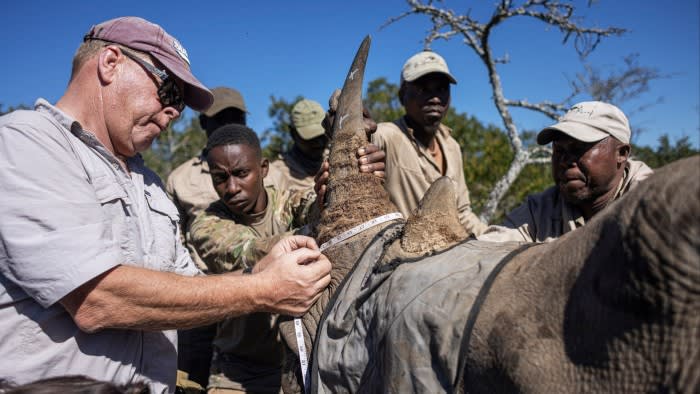
Unlock the Editor’s Digest for free
Roula Khalaf, Editor of the FT, selects her favourite stories in this weekly newsletter.
South Africa is proposing allowing tourists to use rhino horn powder within its borders for its claimed medicinal effects as part of a wider strategy designed to extract more economic value from the country’s wildlife.
The government is also pushing a six-fold increase in the consumption of game meat, such as antelope, to R28bn ($1.5bn) by 2036 and a similar increase to R11.6bn of plant trade and bioprospecting, which involves the use of plants for pharmaceuticals and cosmetics.
The revamped 10-year plan, known as the National Biodiversity Economy Strategy, envisages particular financial benefits for Black communities historically excluded from the white-dominated wildlife and conservation industries.
It will include the expansion of game ranches and hunting on communal and traditionally held lands. Another goal is to increase the amount of land set aside for conservation from 20mn hectares to 34mn hectares by 2040, while enabling primarily Black communities to benefit economically.
Barbara Creecy, the environment minister, told the Financial Times that the proposals were a way of ensuring that “people in rural areas have an incentive for conservation”. If poorer South Africans living around game reserves were simply excluded, some would resort to land invasions and poaching, she said.
Annette Hübschle, an expert on wildlife conservation at the University of Cape Town, said the proposals challenged what she called a “fences and fines” approach to conservation that was in part a legacy of apartheid. She said the strategy looked “interesting on paper, but the proof of the pudding will be whether it translates into workable solutions”.
South Africa is home to roughly 80 per cent of the world’s wild rhinos, including some black rhinos which are classified as “critically endangered”. Creecy said 450 rhinos were poached last year.
The controversial plan acknowledges international support for a ban on the trade of rhino horn and elephant tusks under the Convention on International Trade in Endangered Species (Cites), but says that South Africa should explore “innovative approaches” to domestic trade.
The strategy document includes allowing initiatives such as “health clinics to administer traditional remedies using rhino horn for health tourists from the Far East, or ivory carving being done locally for local sale and export for personal use”.
The plan, which has been approved by South Africa’s cabinet but is out for public consultation prior to its implementation, has sharply divided opinion.
Creecy said she was unsure if the proposal on rhino horn would “survive the public comment process”. There was a potential contradiction, she conceded, between South Africa’s position that rhino horn had no medicinal properties and its proposal to market it for medical tourism.
Rhino horn is made of keratin, which is the same protein that helps form human hair, nails and skin. In traditional Chinese medicine, it is believed to be a cure for fevers and snake bites and, more recently, has even been proposed as treatment for some forms of cancer.
Critics have branded South Africa’s plan a crude form of “extractive conservation” and say it applies a “farming ethic” to wild animals. Don Pinnock, a lecturer in criminology, said in an article in the Daily Maverick that the emphasis on “consumptive use” and game hunting risked permitting “poaching to be laundered within the legal framework”.
But there has also been strong support. Wandile Sihlobo, an agricultural economics lecturer at Stellenbosch university, said: “What the government is saying is, ‘Let’s give the communities an economic incentive to take care of these lands and assets.’ Having an environment that is pristine and people who are hungry is not fair. We have to find a balance.”
Sihlobo added that a large stock of horns had been created mainly from rhinos who had been trimmed to discourage poaching. “We have spent decades fighting poachers, so we should be open to this economic solution,” he said.
Kevin Leo-Smith, a director at Rhino Revolution, which advocates for “any positive approach” to conservation, including sustainable use of rhino horn from live animals, said the overall biodiversity strategy was an important step in applying an economic lens to conservation.
The medical tourism component was “creative”, he added, emphasising that the key was to make “a live rhino worth more than a dead rhino”.
Read More: World News | Entertainment News | Celeb News
FT










